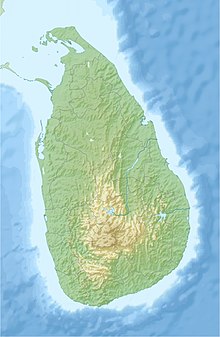Hakgala Strict Nature Reserve
| Hakgala Strict Nature Reserve | |
|---|---|
|
IUCN category Ia (strict nature reserve)
|
|

The reserve as seen from the botanical garden
|
|
|
Hakgala Strict Nature Reserve
|
|
| Location | Central Province and Uva Province, Sri Lanka |
| Nearest city | Nuwara Eliya |
| Coordinates | 6°55′N 80°48′E / 6.917°N 80.800°ECoordinates: 6°55′N 80°48′E / 6.917°N 80.800°E |
| Area | 1,142 ha |
| Established | February 25, 1938 |
| Governing body | Department of Wildlife Conservation |
Hakgala Strict Nature Reserve is one of the three strict nature reserves in Sri Lanka, the only one in the wet zone. The reserve is an important although isolated cloud forest which supports a number of faunal species including some endemics. The area was designated a strict nature reserve on 25 February 1938. The reserve is adjacent to and contiguous with the Hakgala Botanical Garden which was founded in 1860.
The Hakgala reserve covers an area of 11.42 square kilometres (4.41 sq mi) the altitude of which ranges from 1,650 metres (5,410 ft) to 2,178 metres (7,146 ft) at the summit of Hakgala peak. The reserve receives 2,400 millimetres (94 in) of mean annual rainfall with rain falling on 211 days of the year. The soil of the reserve consists of red-yellow podsols this is due to the bookly. The reserve is situated on the south bank of Sita-Eliya and includes most of the Hakgala massif. The name of this range is derived from several of the peaks being said to have the shape of an elephant's jaw. In the Sinhala language Hak is jaw and Gala is rock.
The nearby Sita Amman Hindu temple of Sita Eliya has a tradition that goes back to the legend of Ramayana. According to folk legends, the demon king of Lanka, Ravana, kept Sita hidden in this area.
Vegetation of the reserve consists of montane cloud forests. These forests are noted for endemic archaic Hortonia floribunda and many orchids. Endemics of Calophyllum walkeri, Syzygium rotundifolium, Elaeocarpus montanus are the common floral species of the reserve. In the undergrowth many Strobilanthes species are common. According to height, the forest is categorised into two types; dwarf forests which is dominated by low growing Osbeckia buxifolia while taller forests featured by Rhododendron zeylanicum and Actinodaphne speciosa.
...
Wikipedia

